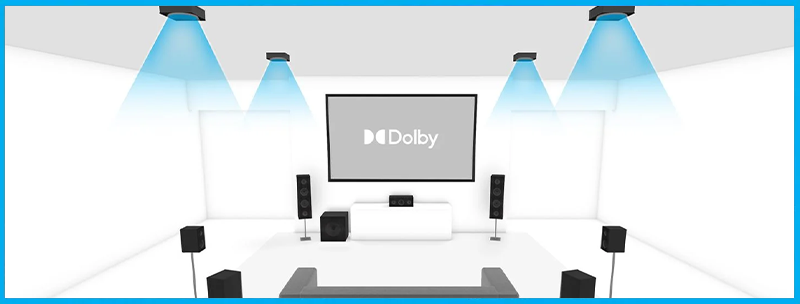In Ceiling Home Cinema
Ceiling mount speakers offer a great solution for a home cinema system, especially in multi-use spaces like the family room or living area. If correctly designed this kind of speaker system will be completely out of sight, will sound great and will give the perfect soundstage.
For simplicity’s sake, in this article, we will focus on a simple 5.1 speaker setup. This is normally the go-to setup in a conventional living room home cinema system, unless a dedicated cinema room is being prepared. In larger, dedicated home cinema spaces, one might consider a more complex system using dedicated speakers for Dolby Atmos or DTS:X. Such systems require more thought and detailed designs but the results are quite worth the effort.
Speaker Placement
When designing a ceiling mount speaker system, one needs to consider the shape of the room, the seating position and the placement of the TV.
The speaker placement differs depending on whether the TV is placed in a corner or on a wall/tv table opposite the seating area.
TV on a wall or TV unit (not in a corner)
For a 5.1 system, ideally, the three front speakers should be in line and equidistant from the wall on which the TV is mounted. The most important element in a home cinema sound system is the centre channel. This is because most of the dialogue comes from this channel and placing the centre channel speaker in the middle of the centre line of the TV will result in a clearer and more legible dialogue. The front left and right speakers should be at equal distance from the centre channel and ideally placed between 22 to 30 degrees from the main listening position. This gives a wider soundstage resulting in a more immersive experience.
The surround (rear) speakers should ideally be mounted behind the seating position (up to 110 degrees behind the main seating position) thus giving that deep effect that only a well-designed home cinema system can.

Speaker Placement when TV is in a corner of the room
When the TV is placed in a corner, the same principle as above holds. The Centre Channel speaker should still be installed in line above the TV and the front Left and front Right Speakers placed on either side of the TV, maximising as much as possible the distance from the left/right speaker to the centre speaker for as wide a soundstage as possible. It is important however, to have the left and right speakers equidistant from the centre speaker.
The rear speakers should be placed on the corners of the room on either side of the seating position, not in the corner opposing the TV.

Subwoofer Placement
The subwoofer is the speaker that gives us the lower frequencies. The sub-bass.
Although in most cases the subwoofer is placed at the front of the room it can also be behind the sitting position since the low frequency coming out of the subwoofer is omnidirectional.
This means that the subwoofer may actually be placed anywhere in the room. The only factors to consider are the wiring of the subwoofer and the fact that the closer the subwoofer is placed to a corner, the more acoustically amplified this sounds.
The Quality Chain
Like anything else where quality is the goal, every component is important when deciding which system to go for, from the choice of speaker cable, to speaker brand and electronics. Every component of a home cinema system is important. Having an award winning DENON or Marantz Home Cinema amplifier needs proper speakers from the likes of KEF, Bowers & Wilkins or Polk Audio. Even the Speaker cables and interconnects play their part, wiring using a cheap seaker cable will effect the overall result when compared to using proper cables.
How do I connect the speakers ?
We have now decided where to place the speakers, however, how should the wiring be prepared for such a system ?
The amplifier (normally placed under the TV) is the heart of the system. The amplifier includes all the processors that will decode the Dolby Atmos, Dolby Digital, DTS or whatever home cinema encoding your source (TV, PLAYSTATION, XBOX, SATELLITE RECEIVER etc..) feeds it.
All speakers, including the subwoofer are wired to the Amplifier. The subwoofer would normally also need a seperate power supply since normally subwoofers are active (have a built-in dedicated amplifier). While Speakers need a speaker cable, the subwoofer needs a dedicated subwoofer cable.








